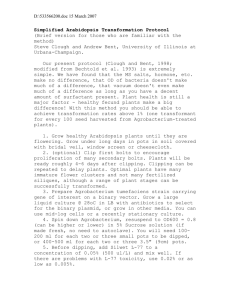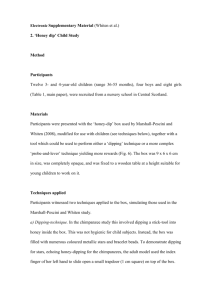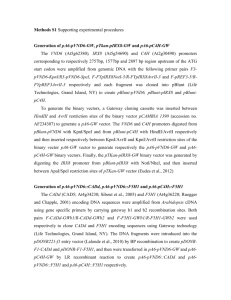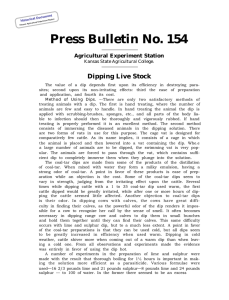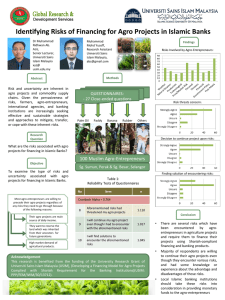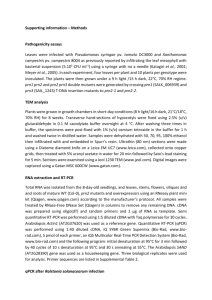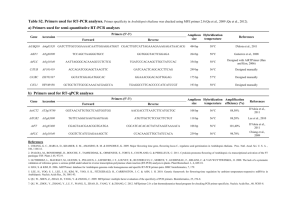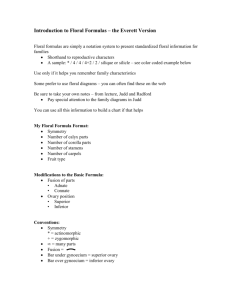Arabidopsis Floral Dip Transformation Protocol
advertisement
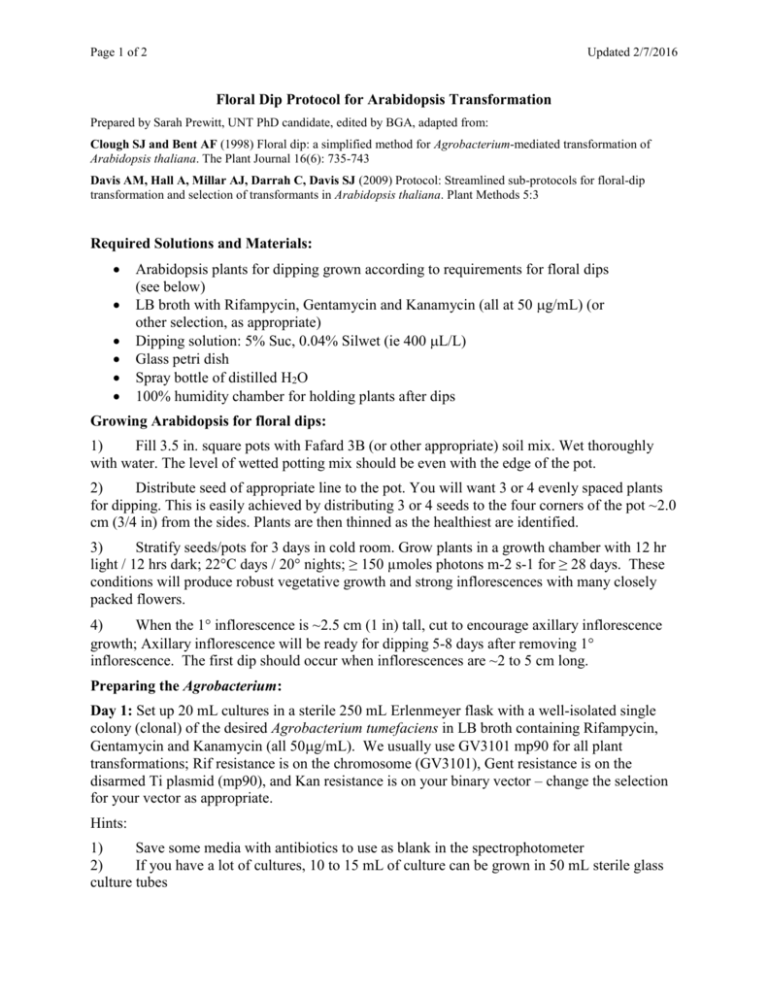
Page 1 of 2 Updated 2/7/2016 Floral Dip Protocol for Arabidopsis Transformation Prepared by Sarah Prewitt, UNT PhD candidate, edited by BGA, adapted from: Clough SJ and Bent AF (1998) Floral dip: a simplified method for Agrobacterium-mediated transformation of Arabidopsis thaliana. The Plant Journal 16(6): 735-743 Davis AM, Hall A, Millar AJ, Darrah C, Davis SJ (2009) Protocol: Streamlined sub-protocols for floral-dip transformation and selection of transformants in Arabidopsis thaliana. Plant Methods 5:3 Required Solutions and Materials: Arabidopsis plants for dipping grown according to requirements for floral dips (see below) LB broth with Rifampycin, Gentamycin and Kanamycin (all at 50 g/mL) (or other selection, as appropriate) Dipping solution: 5% Suc, 0.04% Silwet (ie 400 L/L) Glass petri dish Spray bottle of distilled H2O 100% humidity chamber for holding plants after dips Growing Arabidopsis for floral dips: 1) Fill 3.5 in. square pots with Fafard 3B (or other appropriate) soil mix. Wet thoroughly with water. The level of wetted potting mix should be even with the edge of the pot. 2) Distribute seed of appropriate line to the pot. You will want 3 or 4 evenly spaced plants for dipping. This is easily achieved by distributing 3 or 4 seeds to the four corners of the pot ~2.0 cm (3/4 in) from the sides. Plants are then thinned as the healthiest are identified. 3) Stratify seeds/pots for 3 days in cold room. Grow plants in a growth chamber with 12 hr light / 12 hrs dark; 22°C days / 20° nights; ≥ 150 µmoles photons m-2 s-1 for ≥ 28 days. These conditions will produce robust vegetative growth and strong inflorescences with many closely packed flowers. 4) When the 1 inflorescence is ~2.5 cm (1 in) tall, cut to encourage axillary inflorescence growth; Axillary inflorescence will be ready for dipping 5-8 days after removing 1 inflorescence. The first dip should occur when inflorescences are ~2 to 5 cm long. Preparing the Agrobacterium: Day 1: Set up 20 mL cultures in a sterile 250 mL Erlenmeyer flask with a well-isolated single colony (clonal) of the desired Agrobacterium tumefaciens in LB broth containing Rifampycin, Gentamycin and Kanamycin (all 50g/mL). We usually use GV3101 mp90 for all plant transformations; Rif resistance is on the chromosome (GV3101), Gent resistance is on the disarmed Ti plasmid (mp90), and Kan resistance is on your binary vector – change the selection for your vector as appropriate. Hints: 1) Save some media with antibiotics to use as blank in the spectrophotometer 2) If you have a lot of cultures, 10 to 15 mL of culture can be grown in 50 mL sterile glass culture tubes Page 2 of 2 Updated 2/7/2016 Grow ~24 hours until O.D.600 is approximately 2.0. Usually a 10X dilution will spec in good range. Floral dip procedure: Day2: 1) Remove 1-2 mL of Agro culture to a clean microfuge tube for miniprep processing to ensure plasmid in Agrobacterium is the desired plasmid. Digest plasmid directly or transform back into E. coli to amplify. 2) Harvest cells by centrifugation in sterile Oakridge tubes in an SS34 rotor for 10 minutes at 5,000g, or in 50 mL Falcon tubes in a swinging bucket rotor at 3000 rpm (less effective, but still gets most of the cells). The rotor should not be chilled, but a chilled rotor probably does not hurt. 3) Resuspend the bacterial pellet in 15 mL dipping solution (5% Suc, 0.04% silwet) to a calculated O.D.600 of 1.0 to 1.5; Pour up to 40 mL of the solution into a glass petri dish 4) Invert the Arabidopsis inflorescences into the solution such that only the flowers, and as little vegetative material as possible, are submerged; hold for a few seconds. . It is important to hold the pots, plants and soil in a way that prevents them from falling into the Agro solution. 5) Alternatively, if the inflorescences are not long enough for convenient dipping, the tips can be treated by placing a few drops of Agro solution directly on flowers 6) After dipping, spritz the plants gently with distilled water and put the plants in a 100% humidity chamber. This chamber is created spaying the inside of a relatively enclosed space with little air flow with water (i.e., a garbage bin turned upside down). 7) Agro strains and pots are generally processed one at a time for greatest viability (extended exposure of Agro or plants to concentrated Silwet may reduce viability) 8) Keep dipped plants in the 100% humidity chamber for 24 hrs before returning to the growth chamber. 9) Repeat the dips after ~6 days. A third dip can be done as well, ~6 days after that. 10) Restrain inflorescences to prevent cross-contamination between dipped pots using bamboo steaks or tubes made from overhead acetate sheets. 11) Continue watering for ~2 weeks to keep developing siliques healthy, while starting to reduce water to prevent further flowering, but allowing healthy seed development. 12) When siliques are mature and have lost chlorophyll, harvest seeds into microcentrifuge tubes with a small hole in the cap, and dry in a desiccator with Drierite for 7-10 days. 13) Place the seeds in a zip-loc bag and transfer to -70C for 2 days and then transfer back to desiccation for 1 day – minimize the amount of condensation that can form directly on the seeds. 14) Store the seed appropriately and select T1 transgenics.

